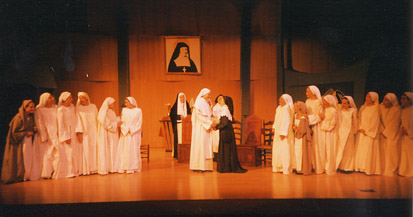Les
Visitandines
(Sisters of the Visitation)
A Performance History

François
Devienne (1759-1803) was already renowned as one of Europe’s greatest
flute and bassoon virtuosos when he wrote Les Visitandines, his
fourth opera. The première on July 7, 1792, was such an enormous
hit that it catapulted Devienne into instant fame in the world of composition
as well.
Within a few weeks of the first performance, almost every Parisian on the street could hum several of its melodies; but the opera never would have been permitted on the French stage before the Revolution, which had begun in 1789 and had initiated a rising tide of anticlerical sentiment. Though today’s audiences will view Sisters of the Visitation simply as poking gentle fun at the formality of religious orders, audiences during the Revolution reveled in it as one of the manifestations of their newly granted right to criticize members of the clergy.
The road to success had been fraught with struggle, however. In 1790, when Louis-Benoît Picard submitted his libretto to the Théâtre Favart (also known as the Opéra-Comique), the administrators rejected it with the comment that the situations were exaggerated and the comedy was forced. Since the anticlericalism of the Revolution had not yet become fervent, the theater’s directors were undoubtedly uncomfortable with such blatant satire of religious orders. Picard waited a year and submitted the libretto to a rival opera house, the Théâtre de la rue Feydeau. This time the circumstances were favorable: criticism of the church had become fashionable, and it didn’t hurt at all that Devienne himself was the principal bassoonist of the Feydeau’s orchestra. Les Visitandines was accepted.
In late-eighteenth-century Paris, comic operas provided the type of entertainment that Broadway musicals do for us today. When a show was a hit, it ran in repertory with several others for as long as its popularity endured. Whether Devienne was merely trying to capitalize on the tremendous success of Les Visitandines from the 1792 season or attempting to strengthen its ending, he decided to lengthen its two acts to three for the next season. Musically, this expansion merely consisted of inserting a folk song in Act 2, substituting a new finale to the second act, and writing one number for the third. Dramatically, the plot introduced new characters and a completely different dénouement, which was considerably more irreverent than the first one.
The opera’s instantaneous success in 1792 had prompted a Parisian publisher to get to work right away and turn out printed editions of both the score and orchestral parts less than four months after the première. While the new three-act version was being performed in Paris in 1793, the printed two-act edition was spreading quickly throughout Europe. In addition to numerous performances in French, productions were mounted in German, Swedish, Dutch, Danish, and Spanish translations in the first decade of the opera’s existence. From 1793 to the end of the century, the three-act version was performed in Paris on an average of once a week. Beginning in 1800, the two versions were given in alternation until 1806, when the three-act version was retired altogether. Les Visitandines in two acts was then regularly performed throughout the remainder of the Napoleonic era.
Napoleon’s second exile in 1815 began a ten-year absence of Les Visitandines from the repertory because the restored Bourbon monarchy made it illegal to represent the church onstage in a disrespectful manner. But in 1825, soon after Charles X began his reign, the two-act version was revived in a changed setting under the title, Le Pensionnat de jeunes demoiselles (The Young Ladies’ Boarding School). Not only had the convent been changed to a girls’ school, but the locale was now Belgium. The same year, another theater produced the opera under the title, Les Français au sérail (The Frenchmen in the Harem). Though no documentation about this production is extant, it is easy to imagine what the changes would have entailed. Perhaps the most provocative revival of all took place in 1872. The setting reverted to the convent, but this time the theater was the Folies Bergère, that Parisian music hall so notorious for its naughtiness. The final production of Les Visitandines prior to its 1997 revival came in 1920, when the two-act version played in Paris.
The added music for the three-act version was never published, and no trace of the extra music could be found until 1985, when I discovered a manuscript copy in the Bibliothèque Municipale in Lille, France. This library is one of only three in the world which possess a set of the original printed orchestral parts of 1792. After I edited the opera, Miriam Ellis made the first singing translation of it in English, and on 31 May 1997 the three-act version of Les Visitandines received its first performance in 191 years at the University of California, Santa Cruz.
Click for a list of characters with vocal ranges and a plot synopsis.